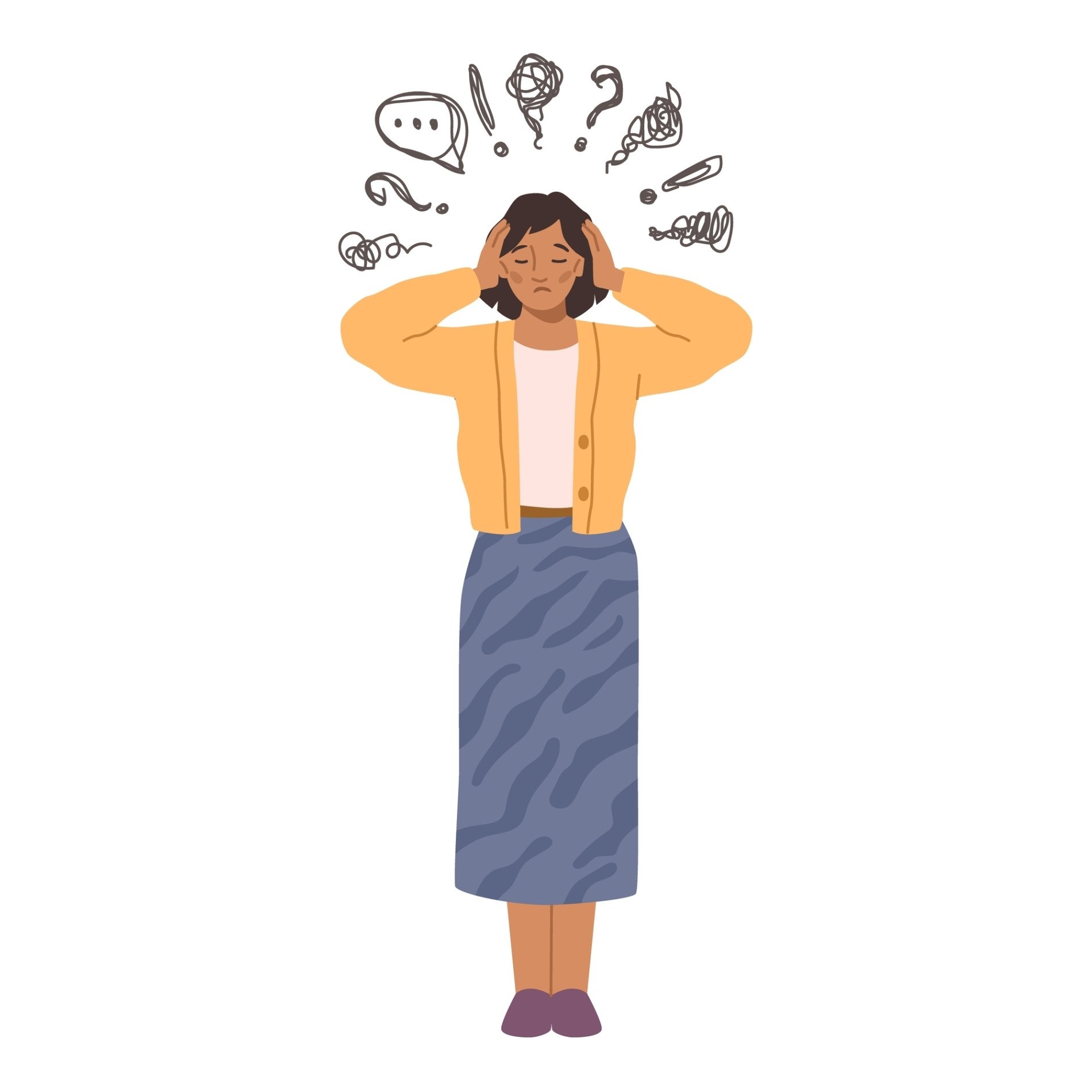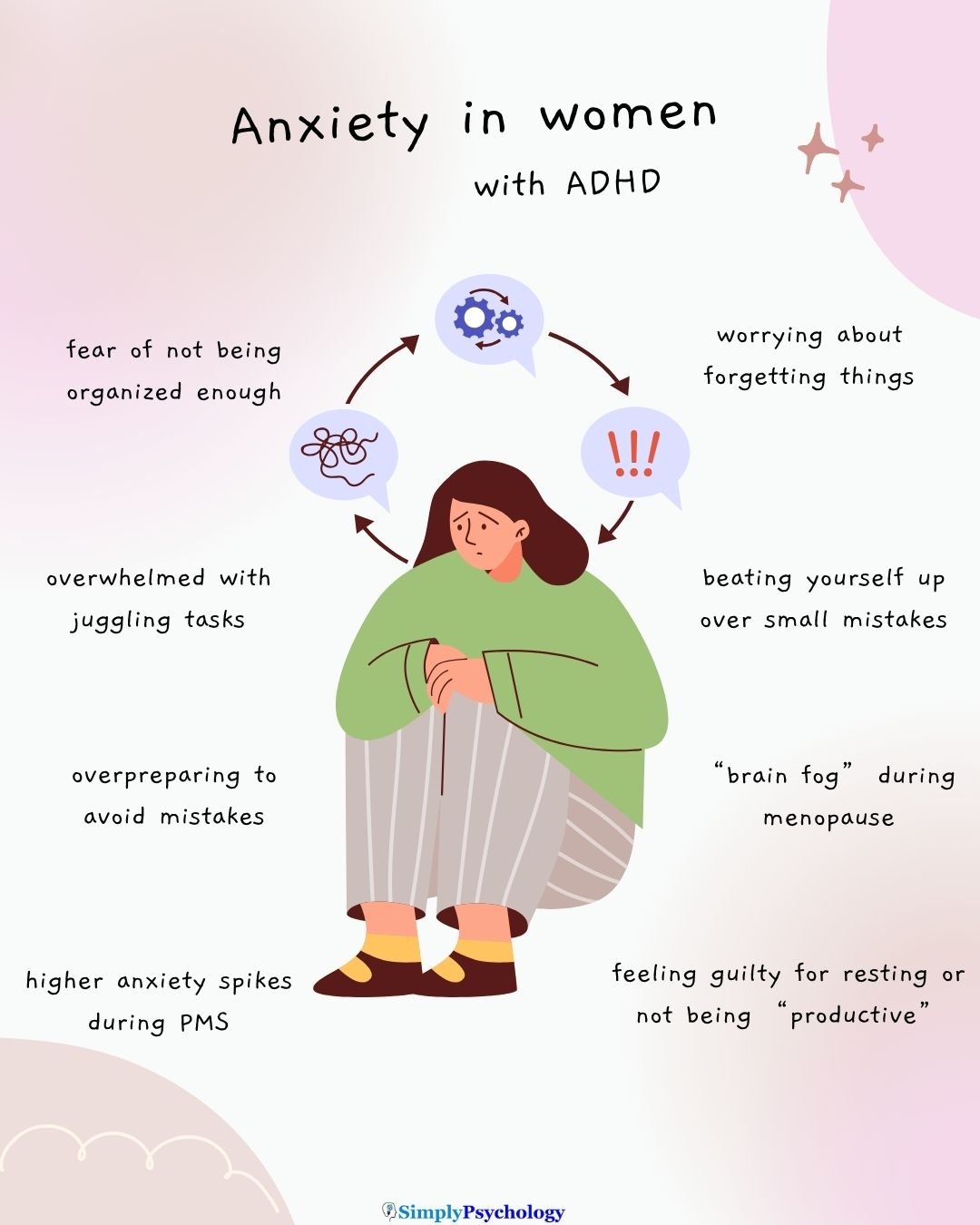Living with ADHD as a woman often brings a double challenge — managing ADHD symptoms while coping with anxiety.
Research shows that anxiety disorders are among the most common co-occurring conditions with ADHD.
About one-third of women with ADHD also have an anxiety disorder — a rate several times higher than in women without ADHD.

This overlap isn’t coincidental. ADHD traits and gendered expectations often reinforce each other, creating fertile ground for worry and self-doubt.
How Anxiety Feels for Women with ADHD
For many women, ADHD-related anxiety isn’t just ordinary nervousness — it’s a persistent, gnawing tension that colors daily life.
ADHD and anxiety often feed off each other, creating a cycle of stress, self-doubt, and overwhelm.
Here’s how that often shows up:
1. Overwhelming Sensory Overload
What others see as “busy” can feel unbearable for women with ADHD. A crowded, noisy room or bright lights can trigger instant anxiety — heart racing, chest tightening, or the urge to escape.
Because ADHD brains struggle to filter input, everything hits at once. When you’re already on high alert, ordinary sounds or clutter can feel like too much.
2. Constant Worry and Overthinking
Anxiety often sounds like a looping inner monologue: “What did I forget? What’s going to go wrong next?”
Past mistakes make women hyperaware of what they might be missing. Even small tasks — sending an email, paying a bill — can spark stress.
Overthinking takes over: “Did I say something dumb? Are people noticing I’m struggling?”
The mental noise fuels both anxiety and distraction, making it harder to focus on the present.
3. Fear of Failure and Rejection
Many women with ADHD carry a deep fear of letting others down. Being misjudged as careless or unreliable can leave lasting scars.
Rejection Sensitive Dysphoria (RSD) — extreme sensitivity to criticism or rejection — can make even small risks feel unsafe.
After enough setbacks, avoidance takes over: skipping projects, events, or opportunities just to avoid failure.
But avoidance fuels procrastination, and anxiety spikes as deadlines loom.
4. Using Anxiety as a Coping Tool
Some women unknowingly rely on anxiety to function. As one woman put it, “I’d learned to use my anxiety to manage my executive dysfunction!”
That adrenaline surge can momentarily sharpen focus and push tasks across the finish line. But it’s a fragile system.
Living on panic energy eventually leads to exhaustion, irritability, and burnout — leaving little space for calm or joy.

Internalizing and “Masking” Struggles
Experts suggest that many women with ADHD internalize their difficulties rather than act out.
Instead of being labeled “hyperactive,” they tend to blame themselves for mistakes and work hard to conceal their struggles.
Over time, that self-blame and masking can fuel chronic anxiety.
“Girls tend to suffer silently for many years… many develop anxiety because of their untreated ADHD symptoms… So, they get anxious or develop compensatory strategies,” explains ADHD specialist Dr. Patricia Quinn (Edge Foundation).
Years of unmanaged ADHD — disorganization, forgetfulness, or feeling “different” — can create a constant undercurrent of worry.
A woman may live in a near-permanent state of vigilance, always wondering what she’s forgotten or done wrong, which eventually develops into full-fledged anxiety about everyday life.
Misdiagnosis and Late Recognition
Because ADHD often presents differently in women, many go undiagnosed until adulthood.
It’s common for anxiety or depression to be what finally prompts them to seek help.
“ADHD is tricky,” says psychologist Dr. J. Russell Ramsay (CHADD). “The mood or anxiety elements may be what finally drives a woman to go get help.”
Often, women are treated for anxiety for years before anyone recognizes the underlying ADHD. One woman shared on an ADHD forum:
“By the time I was a pre-teen it was manifesting as some gnarly anxiety… it was easy for doctors to just be like, ‘yep, you have GAD!’… I honestly think the ADHD was really the root of the problem.”
Because girls are typically less disruptive, more likely to daydream, and better at masking, their ADHD symptoms are often mistaken for sensitivity, laziness, or simple anxiety.
In reality, their concentration and memory challenges are what generate the stress and worry they’re blamed for.
The Role of Hormones in ADHD and Anxiety
Fluctuating estrogen and progesterone levels can significantly influence dopamine activity — and with it, ADHD and anxiety symptoms in women.
Estrogen generally enhances dopamine and serotonin, improving mood, focus, and executive function.
By contrast, high progesterone can dampen dopamine’s effects, which is why many women might notice their ADHD medication feels less effective during progesterone-dominant phases.
Hormonal Cycles and Symptom Fluctuations
Hormonal shifts often cause ADHD and anxiety symptoms to ebb and flow across the menstrual cycle and major life stages.
During ovulation, rising estrogen may sharpen focus and lift mood. But in the late luteal phase — just before menstruation — falling estrogen and higher progesterone can trigger brain fog, irritability, and heightened anxiety.
One woman described the experience vividly:
“Around a week before my period starts, I feel heavy again, unmotivated, depressed… Hanging up the laundry and doing other household tasks is like climbing a mountain, and 99% of the time they end with me in tears.”
Pregnancy brings another hormonal shift. For some, surging estrogen improves focus and organization; about 20% of women report feeling mentally clearer.
For others, ADHD symptoms worsen with fatigue, “pregnancy brain,” and emotional swings — affecting roughly one-third of pregnant women with ADHD.
Hormonal Changes Across the Lifespan
Perimenopause and menopause bring steep drops in estrogen, often leading to “brain fog,” memory lapses, and worsening ADHD symptoms.
Many women find that attention, motivation, and emotional regulation decline as hormones fluctuate and eventually stabilize at lower levels.
Perinatal ADHD and Reproductive Health Risks
Women with ADHD face distinct challenges during pregnancy and the postpartum period. Key risks include:
- Unplanned Pregnancy: ADHD-related impulsivity and disorganization may contribute to higher rates of unplanned pregnancies (and even teenage motherhood) among women with ADHD.
- Pregnancy Complications: Mothers with ADHD can experience more pregnancy and birth complications – for instance, significantly higher odds of unplanned caesarean delivery, premature birth, and infection. Difficulty managing prenatal appointments can lead to missed early warnings of complications.
- Emotional Dysregulation: ADHD’s hallmark difficulty with regulating emotions can intensify during pregnancy and after childbirth. Many women report heightened stress and overwhelm; in fact, untreated ADHD in pregnancy is linked to higher rates of depression, feelings of isolation, and family conflict.
- Postpartum Mood Disorders: The risk of postpartum depression and anxiety is dramatically elevated. One analysis found that mothers with ADHD have a 5- to 6-fold higher risk of developing postpartum depression/anxiety than neurotypical mothers.
Despite these findings, ADHD’s impact on maternal health is often overlooked. As one expert review notes, “the first and most important intervention... is increased awareness and monitoring” for pregnant patients with ADHD.
Both clinicians and patients need more education, and further research is urgently needed to guide safe prenatal care and support for women with ADHD.
Breaking the Cycle: Strategies to Manage ADHD and Anxiety
Living with both ADHD and anxiety can feel overwhelming, but the right combination of strategies can make a big difference.
Managing both conditions means addressing them together — supporting executive function while calming the nervous system.
Get the Right Diagnosis and Support
If you suspect ADHD, and anxiety is part of the picture, start with a comprehensive evaluation.
Accurate diagnosis is essential. As Dr. Patricia Quinn notes, even women who appear to be “doing well” may be coping at a significant emotional cost.
A psychologist or psychiatrist can assess ADHD using questionnaires and interviews. Be sure to mention anxiety symptoms, as both need to be recognized and treated.
Cognitive-behavioral therapy (CBT) may help improve organization, time management, and anxious thought patterns.
Medication may also play a role: stimulants, non-stimulant ADHD meds, or anti-anxiety treatments.
For some, managing ADHD reduces anxiety dramatically; for others, a combination of medication and therapy works best. Finding the right balance with a healthcare provider is key.
Build Self-Awareness of Triggers
Understanding your triggers helps you take back control.
Try journaling or noting patterns on your phone: When does your anxiety spike? Are there common situations — unstructured social events, tight deadlines, noisy environments — that worsen both ADHD and anxiety?
You might notice that disorganization or multitasking makes symptoms worse. For instance, if being late sends you into panic mode, plan time buffers or set extra alarms.
Self-awareness also means noticing when ADHD contributes to anxiety — like realizing, “I got anxious because I forgot that appointment.”
Once you see the link, you can build systems, such as calendar reminders, to prevent the spiral.
Externalize and Organize
Much of the anxiety that comes with ADHD stems from fear of forgetting — deadlines, details, or commitments.
Externalizing those tasks can relieve the pressure. Use planners, phone reminders, sticky notes, or to-do apps — whatever fits your style.
If you worry about forgetting bills, automate payments or schedule alerts. If social anxiety comes from missing cues or messages, use checklists for getting ready or reminders to follow up.
These tools act as an “external brain,” helping your mind relax. When you trust your systems, your anxiety quiets down, too.
Practice Self-Compassion and Reframe Your Thoughts
Women with ADHD often internalize years of self-criticism — calling themselves lazy, scattered, or “too much.”
But harsh self-talk only fuels anxiety. Try catching those thoughts and reframing them with compassion:
- Instead of “I’m a failure for being late again,” try “Timing is tricky with ADHD — I’ll set a better reminder next time.”
Your brain works differently, not deficiently. Think about what you’d say to a close friend — and offer yourself the same kindness.
Use Mindfulness and Stress-Reduction Techniques
Practices that calm the body can ease anxiety and improve ADHD focus.
Mindfulness meditation, deep breathing, yoga, or even short walks can help lower stress hormones and improve attention.
Mindfulness means gently bringing your awareness back to the present — something that can feel difficult for ADHD brains but pays off with practice.
Even a few minutes of breathing or stretching daily can help reduce baseline anxiety.
Physical activity is especially powerful: it burns excess energy, regulates mood, and boosts dopamine.
Whether it’s dancing, gardening, or walking your dog, the goal is finding movement that feels grounding, not like a chore.
Create Realistic Routines and Boundaries
Structure helps calm both the ADHD mind and an anxious nervous system. Routines act like scaffolding — reducing decision fatigue and helping you feel anchored.
A simple morning checklist, for instance, can ease the “What am I forgetting?” panic.
Schedule rest as intentionally as work. Say no when you’re at capacity — boundaries prevent burnout.
Breaking big tasks into smaller steps also reduces anxiety. Instead of an all-nighter, try short, focused sessions over several days.
These small adjustments build predictability and confidence, helping you feel more in control.
Reach Out and Don’t Go It Alone
Support can make a world of difference. Online ADHD communities, local groups, or therapy groups provide validation and shared coping tips.
Hearing “me too” from others with similar experiences can be profoundly relieving.
If you’re in school or at work, explore accommodations like flexible deadlines or quiet workspaces to reduce anxiety triggers.
Educate close friends or family about what ADHD and anxiety look like for you — having a few people who “get it” can transform your sense of safety and belonging.
References
Andersson, A., Garcia-Argibay, M., Viktorin, A., Ghirardi, L., Butwicka, A., Skoglund, C., Bang Madsen, K., D’onofrio, B. M., Lichtenstein, P., Tuvblad, C., & Larsson, H. (2023). Depression and anxiety disorders during the postpartum period in women diagnosed with attention deficit hyperactivity disorder. Journal of Affective Disorders, 325, 817-823. https://doi.org/10.1016/j.jad.2023.01.069
Baker, A. S., Wales, R., Noe, O., Gaccione, P., Freeman, M. P., & Cohen, L. S. (2022). The Course of ADHD during Pregnancy. Journal of Attention Disorders. https://doi.org/10.1177/1087054720975864
Fuller-Thomson, E., Lewis, D. A., & Agbeyaka, S. K. (2016). Attention-deficit/hyperactivity disorder casts a long shadow: Findings from a population-based study of adult women with self-reported ADHD. Child: Care, Health and Development, 42(6), 918-927. https://doi.org/10.1111/cch.12380
Toda, S., Tsushima, S., Takashio, O., Kikuchi, M., Ohta, H., Nagasawa, T., Iwanami, A., & Ohashi, Y. (2024). The repressed life of adult female patients with mild ADHD. Frontiers in Psychiatry, 15, 1418698. https://doi.org/10.3389/fpsyt.2024.1418698
Walsh, C. J., Rosenberg, S. L., & Hale, E. W. (2022). Obstetric complications in mothers with ADHD. Frontiers in Reproductive Health, 4, 1040824. https://doi.org/10.3389/frph.2022.1040824

